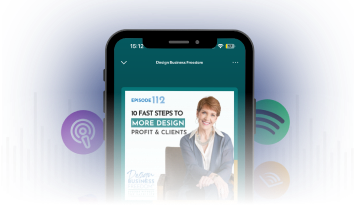The Four Steps to Landing Every Interior Design Project
As an interior designer, landing a project isn’t just about showcasing your portfolio—it’s about establishing trust and building rapport with potential clients from the very first interaction. A thorough and strategic discovery process ensures that every client is the right fit for your business and that you get better design clients. Here we’ll explore the four steps to landing every project by deepening client trust and refining your approach to inquiries.
1. Deploying Your Golden Door Qualifier
The first step to landing every project starts with your “Golden Door Qualifier.” This is essentially your website’s inquiry form, but with a more strategic approach. The goal here is to use this form not just as a contact point but as a way to vet potential clients, ensuring they are serious, committed, and a good fit for your services. By doing so, you set yourself up to get better design clients who align with your business goals.
Your inquiry form should go beyond the basics. Yes, you need the client’s name, email, and phone number, but you should also include questions that help you understand their project scope, budget, and timeline. For instance, asking for a project address allows you to research the property beforehand, while inquiring about their desired start and completion dates helps you manage expectations from the get-go.
One of the most important aspects of this qualifier is setting the tone. Adding a friendly note at the top of the form, such as, “We are currently booking for Spring 2025,” creates urgency and positions your business as in-demand. This not only sets expectations but also filters out tire kickers who aren’t ready to commit.

2. Asking the Right Questions
Once you’ve captured the basics, it’s time to dig deeper with questions that reveal more about the potential client and their project. For example, you might ask, “What is your planned interior investment?” instead of using the term “budget.” This subtle shift in language encourages clients to think of your services as a valuable investment rather than just a cost, which is crucial when aiming to get better design clients.
Another key question is whether they have worked with a designer before. This can give you insights into their past experiences and help you gauge whether they might be a good fit. If a client has had multiple negative experiences with previous designers, it could be a red flag indicating they might be difficult to satisfy.
Additionally, asking about their favorite furniture brands can provide clues about their style preferences and spending habits. Whether they favor high-end brands or more budget-friendly options, this information helps you tailor your proposals to match their expectations, making it easier to get better design clients.
3. Conducting Due Diligence
Before you respond to an inquiry, it’s crucial to do your homework. This includes looking up the project address to understand the property’s value and style, which can influence your approach to the project. Use online resources including Zillow or Redfin to gather as much information as possible about the property.
It’s also a good idea to research the client themselves. Check out their social media profiles on platforms like LinkedIn, Instagram, and Facebook to get a sense of their personality, interests, and lifestyle. This background information can be invaluable during your initial consultation, helping you connect with the client on a more personal level and ultimately helping you get better design clients.
4. Setting the Stage for Success
The final step in the process is to set clear expectations with the client from the start. This involves being upfront about your availability, project timelines, and the scope of your services. If a client’s desired start date doesn’t align with your current schedule, let them know and offer alternatives, such as placing them on your VIP paid waitlist.
Prepare a template for politely declining projects that aren’t a good fit. This ensures that you can maintain professionalism and keep the door open for future opportunities without overcommitting or taking on work that doesn’t align with your business goals.
By following these four steps—deploying a strategic inquiry form, asking the right questions, conducting thorough research, and setting clear expectations—you can build trust and rapport with potential clients, increasing your chances of landing every project.
Wrap Up
Landing every project isn’t about luck—it’s about preparation, strategy, and building strong relationships from the very first interaction. By refining your discovery process and ensuring that each potential client is a good fit for your business, you can set yourself up for long-term success and get better design clients.Remember, the key to a thriving design business lies in the quality of your client relationships, not just the quantity of your projects.
When you’re ready to increase your interior design business profits, work exclusively with ideal clients, and enjoy the time and resources for your extraordinary life, explore your coaching options. We’ve got your back in the business of design and the business of home.





